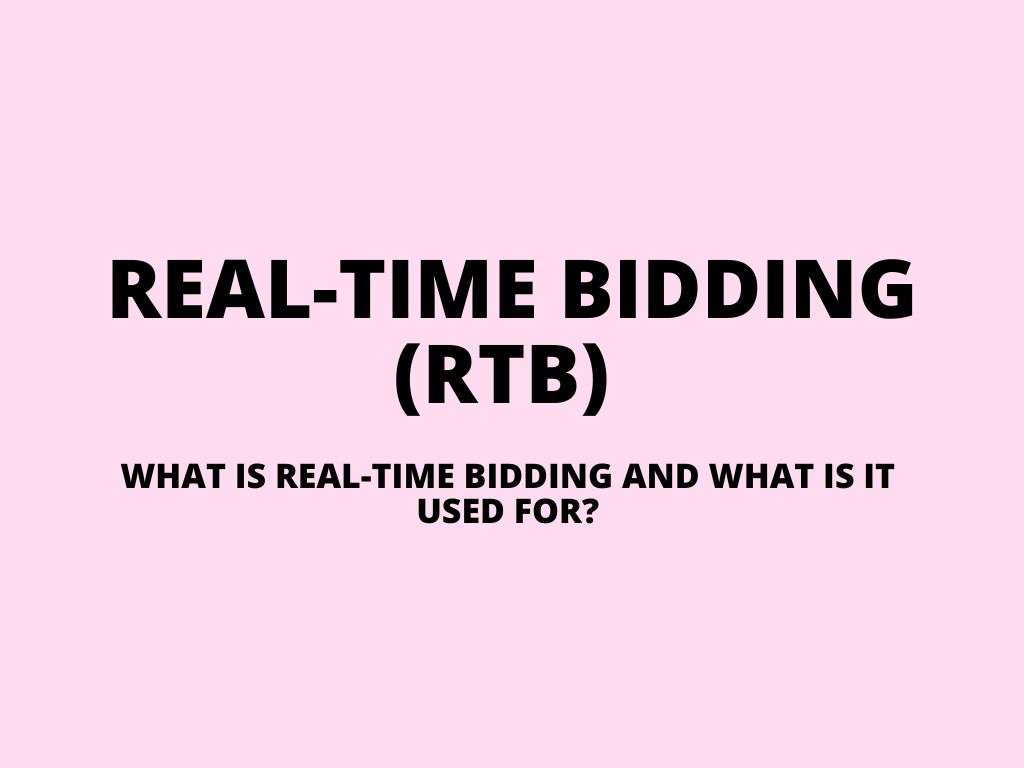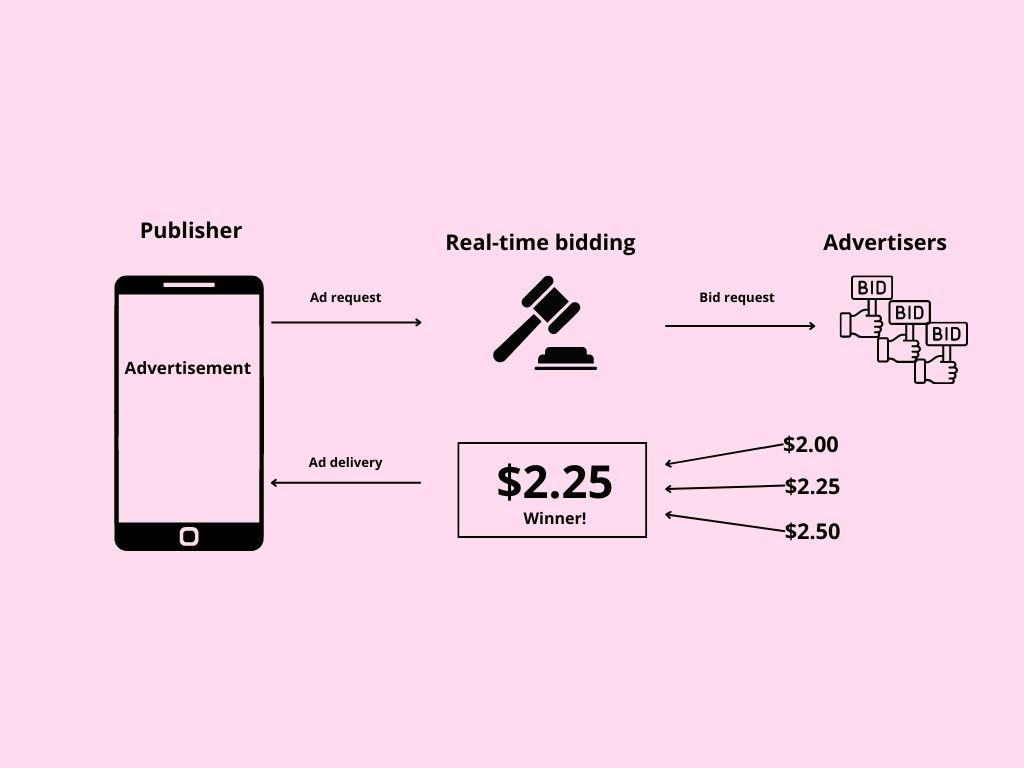
Real-time bidding (RTB) – what is real-time bidding and what is it used for?
Demand-side platforms (DSPs) are utilized to automate the bidding for ad impressions, a process that takes place in real-time within the small window of time between a prospect landing on a webpage and the page fully loading.
What is real-time bidding (RTB)?
Real-time bidding (RTB) is a fundamental component of programmatic advertising, which involves the dynamic buying and selling of ads in real-time and on a per-impression basis. This process occurs through instantaneous auctions facilitated by demand-side platforms (DSPs) and supply-side platforms (SSPs).
Have you ever experienced that particular instance while playing a mobile game when an ad appears between game levels? It is precisely at that moment when a mobile supply-side platform (SSP) conducts an auction, allowing advertisers to bid for the opportunity to show you (the player) an ad through demand-side platforms (DSPs). In a matter of milliseconds, the highest bidder is determined, and their ad is instantly displayed to you.
Now, let’s dive into how real-time bidding functions work.
How does real-time bidding work?

In real-time, multiple advertisers engage in a bidding process for a single impression of a publisher’s inventory. The highest bid, representing the winning ad, is then displayed to the user.
Real-time bidding (RTB) offers advertisers the opportunity to precisely target and focus on inventory that is most relevant to the consumer. This explains why, when reading your favorite clean-eating blog, you often encounter ads promoting your local organic market, or when browsing a mommy blog, you come across advertisements for strollers.
By targeting users in this manner, conversion rates/CTRs are improved, leading to a better return on investment (ROI) and higher effective cost per thousand impressions (eCPMs). Moreover, advertisers can make real-time adjustments to their campaign budgets to optimize performance through RTB. It’s truly impressive how campaigns can perform!
According to research, the global real-time bidding market is projected to grow from USD 6.6 billion in 2019 to USD 27.2 billion by 2024.
What are the advantages and disadvantages of real-time bidding (RTB)?
RTB technology has revolutionized the way advertisers and publishers buy and sell ad inventory programmatically. While there are notable advantages to utilizing this method, marketers should also be aware of its potential drawbacks.
Advantages of RTB
- Precise audience targeting: One of the primary benefits of RTB is its ability to enable advertisers to bid on ad space specifically intended for a particular audience. This precision targeting ensures that advertisers can reach the exact customers who are interested in their offerings.
- Enhanced inventory targeting: RTB empowers publishers to have control over their inventory’s floor price. This means that publishers can set and modify the minimum price for their ad space at any given time, allowing them to maximize their revenue.
By leveraging RTB, advertisers can target their desired audience, while publishers can effectively manage and optimize their inventory’s value, creating a mutually beneficial programmatic advertising ecosystem.
Disadvantages of RTB
- Ad fraud and brand safety concerns: RTB opens the door to potential ad fraud issues, such as invalid traffic or ad placement on low-quality or inappropriate websites. Advertisers must remain vigilant and employ proper measures to mitigate these risks and ensure brand safety.
- Lack of transparency: The complex nature of RTB can sometimes result in a lack of transparency regarding ad placements, pricing, and data usage. Advertisers and publishers need to establish clear communication channels and ensure transparency from their RTB partners.
- Lack of control over context:With the removal of human involvement in programmatic advertising, there is a potential for ad match mistakes that can reflect poorly on advertisers. For instance, imagine reading a news article about a tragic plane crash and seeing an ad for discounted plane tickets below it. Reliance solely on algorithms, keywords, and RTB can sometimes result in unfortunate ad placements that raise questions about advertiser sensibilities.
- Lack of control over content: On the other hand, for publishers, programmatically selling ad impressions means relinquishing control over who and what appears on their pages. Serving unwanted ads or partnering with unfavorable advertisers can have a negative impact on user experience, potentially deterring visitors from returning to the site in the future.
Understanding both the advantages and disadvantages of real-time bidding is crucial for marketers to make informed decisions when implementing programmatic advertising strategies. By capitalizing on the strengths while addressing the challenges, RTB can be a valuable tool in reaching the right audience and optimizing ad campaigns.
Despite the promising future of programmatic advertising and real-time bidding (RTB), there are notable drawbacks that both advertisers and publishers should consider. Two significant disadvantages include the lack of human control, leading to brand inconsistencies and ad placement issues.
The absence of human involvement in programmatic advertising and real-time bidding can lead to mismatched ads, which is an unfortunate consequence of relying solely on algorithms and automation. Advertisers and publishers should be aware of these potential challenges and explore strategies to mitigate them, such as employing thorough brand safety measures and implementing robust ad verification processes.
Real-time bidding vs. header bidding – what is the difference?
When comparing real-time bidding (RTB) and header bidding, it’s important to note that header bidding is a form of programmatic advertising that occurs in real-time. It allows publishers to auction their inventory to multiple ad exchanges simultaneously, resulting in higher bids.
While header bidding and RTB may sound similar, they have nuanced differences that require careful consideration. Header bidding is actually a subset of RTB, which explains why they can be easily confused.
In traditional RTB, each ad exchange conducts its own auction individually. In contrast, header bidding enables multiple ad exchanges to participate in simultaneous auctions through the implementation of RTB technology.
Header bidding can be seen as the enhanced version, or “2.0,” of programmatic ad buying. It provides publishers with the ability to offer their inventory to multiple ad exchanges, expanding opportunities for premium ad placements and reaching a broader audience. Essentially, it overcomes some of the limitations of traditional RTB in terms of audience targeting and reach.
Publishers are the primary beneficiaries of header bidding. Research indicates that among the top 1,000 popular internet sites that employ programmatic advertising, 79.2% utilize header bidding to maximize their revenue and ad inventory management.
Real-time bidding vs. programmatic buying
When comparing real-time bidding (RTB) to programmatic buying, it’s important to note the differences in their models within programmatic advertising. Programmatic buying, specifically programmatic direct, operates on a non-auction basis.
In programmatic direct, publishers directly sell their ad space to advertisers at a negotiated price and for a predetermined duration, without going through an auction process like RTB.
Programmatic buying is particularly suitable for premium display formats, such as full-page takeovers. Given the significant investment involved, advertisers often require guaranteed measures to precisely determine the audience, placement, and context of their ads. This level of control and transparency is essential for high-cost campaigns to ensure optimal results and align with the advertisers’ objectives.
KEY INFORMATION ABOUT REAL-TIME BIDDING (RTB) TO REMEMBER
Real-time bidding (RTB) and the programmatic advertising ecosystem offer numerous advantages, but it’s important to acknowledge the potential drawbacks as well. Here’s a recap of key points to remember – these insights provide a summary of real-time bidding, header bidding, and programmatic buying within the larger programmatic advertising landscape:
-
- RTB is a crucial component of programmatic advertising, enabling automated bidding for ad impressions in real-time using demand-side platforms (DSPs).
- RTB grants both advertisers and publishers significant control over their ad spend and allows for real-time segmentation and optimization of audiences.
- However, the absence of human involvement in media buying can lead to untimely or insensitive ad mismatches, posing risks to the brands of publishers and advertisers.
- Header bidding, a subset of RTB, empowers publishers to offer their inventory to multiple ad exchanges, providing access to premium ad space for advertisers. It represents an enhanced version of RTB.
- Programmatic buying, a non-auction approach, is a safer method for premium ads in programmatic advertising, allowing publishers to directly sell ad space to advertisers for a negotiated price and duration.
Was this article helpful?
Support us to keep up the good work and to provide you even better content. Your donations will be used to help students get access to quality content for free and pay our contributors’ salaries, who work hard to create this website content! Thank you for all your support!
Reaction to comment: Cancel reply